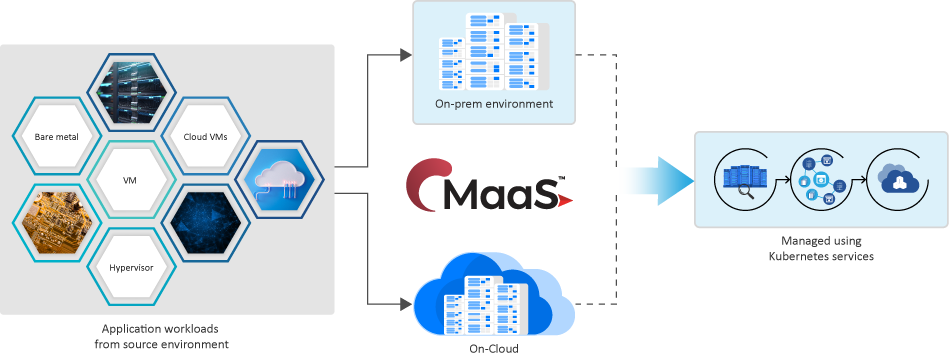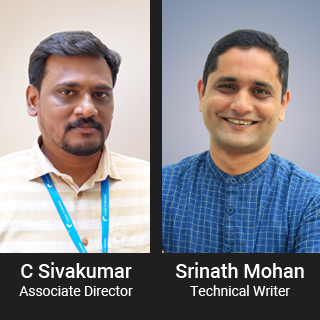Containers represent a paradigm of modularity, offering lean, agile, and scalable alternatives to relatively resource-intensive Virtual Machines (VMs). Businesses planning digital transformation are often torn between choosing either VMs or containers and enjoying the benefits of both by creating an eclectic mix. Corent provides a way out of this analysis-paralysis by assessing the entire environment and offering precise advisories that reflect the company’s aspirations while addressing cost economics. Corent’s MaaS Containerize is a Containerization as a Service (CaaS) product that enables seamless migration to Kubernetes Container Services while offering continuous monitoring capabilities to keep tabs on performance with instrumented metering to handle security threats. It is the industry’s first CaaS that fully automates containerization, and that, too, with near-zero downtime.
The nitty-gritty and benefits of containerization
Containers are executable packages of applications bundled together with all their configurations. By abstracting the package or container away from the OS, one can make it platform agnostic, meaning it can be executed in any environment. This abstraction opens a whole new avenue of cost-effectiveness without compromising security or productivity, especially when using MaaS Containerize.
While containers as a concept have been around for nearly half a century, the advent of Docker Engine in 2013 catalyzed their popularity, leading to large-scale industry adoption. MaaS Containerize was the first in the industry to envisage a fully automated containerization solution, which allowed for seamless, swift migration of apps and their configurations from various sources – be it on-premises bare metal servers/VMs or Cloud-deployed VMs – in any environment in Kubernetes.

Despite the benefits of containerization, companies often fail to capitalize on the opportunities it presents. A McKinsey report said Cloud gridlock and Cloud chaos were among the four prominent causes of failure post-migration. Gridlock is the fallout of IT teams’ inability to build automation techniques and reference architectures necessary for running public cloud platforms securely to ensure resilience and compliance. Chaos entails when the top leadership leaves developers to their devices; the lack of clear ideas leads to divergent strategies, which compromise security, compliance, and resilience.
MaaS advisories offer a rich repository of solutions, including advisories on refactoring applications to circumvent both gridlock and chaos when standards are clearly defined. Applications refactored and re-architected for containerization show greater agility, scalability, and sustainability. McKinsey estimates companies opting for containerization start experiencing higher productivity within 12-18 months; further, clearly defined standards make the repatriation of applications across Clouds seamless, rendering vendor lock-in redundant.
How MaaS Containerize automates container migration
Containerize assesses the workload and matches it with the right topology. Here’s a bird’s-eye view of the process:

1. Assessment of datacenter
MaaS Containerize’s vast knowledge base quickly identifies the app workloads compatible with containerization solutions.
2. Containerization Planning
After the workload is identified, MaaS Containerize furnishes a list of topologies from multiple container deployment architecture solutions. You choose the topology best suited to your needs.
3. Cloud migration
Containerize creates containers and metadata for management within the enterprise DevOps process while providing the next step to move them to Kubernetes Container Service for the selected workload. It launches the containers during the Cloud migration.
How MaaS Containerize augments productivity
MaaS Containerize is the industry’s fastest containerization service built on a secure application-aware migration platform, which provides real-time data synchronization and smart advisories. Its three-step simple process fully automates containerization to help you reap container benefits, including but not limited to:
- Less resource-intensive but more cost-effective
- Quick deployment coupled with reduced booting time
- Modular framework
- Lightweight solutions which punch above their weight
How it ensures continuous uptime
Containerize allows for app data migration as separate data disks. This approach has twin benefits:
- It ensures there is no in-transit data loss
- It enables end-to-end data synchronization from the local environment to Cloud
The combination of zero data loss and real-time end-to-end synchronization ensures the app continues to be available even during migration. This approach addresses a major pain point of industries, which can ill-afford downtime. Summing up the effect of downtime, Statista claimed the average total cost of unplanned application downtime per year hovers around $1.25 billion to $2.50 billion; that’s around a whopping $2,500 to $5,000 per minute!
Who can choose Containerize?
Containerize is a Cloud enabler in that it automates the resource and time-intensive assessment and planning processes to increase efficiencies. MaaS helps integrate DevOps and CI/CD into your app workload containers for end-to-end management. Besides, it improves your application performance by enabling you to test and deploy containers in the release pipeline. Containerize further democratizes an already level playing field. Book a demo today to find how Containerize can help your business grow.

Edited By Shafi Syed. May 27, 2022

